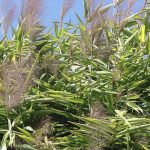Diseases seen in Rice and its Control Measures

Rice is the staple food of more than half of the world’s population. It fulfils more than 50% of the total calorie requirement of the Nepalese people. From nutritional point of view, rice contains high amount of carbohydrates (>75%), other nutrients found are protein, vitamin B and amino acids like lysine and threonine.
Diseases can cause on an average ,about 10 percent reduction in yield ,which may go up from 50 to 90 percent in severe cases. Planting the resistant variety is the simplest and often the most cost effective management of diseases. Some diseases occurring in rice are discussed here:
1. False smut: – Caused by Claviceps oryzae- sativae.
Plants infected with false smut have individual rice grain transformed into a mass of spore balls. These spore balls are initially orange, and then turn into greenish black when these mature.

Control measures:
- Remove infected seeds, panicles, and plant debris after harvest.
- Reduce humidity levels through alternate wetting and drying (AWD) rather than permanently flooding the fields.
- Where possible, perform conservation tillage and continuous rice cropping.
- Use moderate rates of Nitrogen.
- Use certified seeds.
- Treat seeds at 52°C for 10 min.
2. Blast : caused by Pyricularia oryzae.

- Initial symptoms appear as white to gray-green lesions or spots, with dark green borders.
Older lesions on the leaves are elliptical or spindle shaped and whitish to gray centers with red to brownish or necrotic border. - Other symptoms include: Some resemble diamond shape, wide in the center and pointed toward either ends, Lesions can enlarge and coalesce, growing together, to kill the entire leaves.
Control measures:
- Treat the seed at the rate of 10 kg seeds with 5g .Emisan,1g streptocycline or 2.5 g Agrimycine 100 in 10litres of water for 24 hours before sowing.
- Systemic fungicides like triazoles and strobilurins can be used judiciously for control to control blast.
- Grow field resistant varieties.
3. Brown spot: caused by Cochliobolus miyabeanus

– It is a fungal disease that infects the coleoptile, leaves, leaf sheath, panicle branches, glumes, and spikelets.
-Infected seedlings have small, circular, yellow brown or brown lesions that may girdle the coleoptile and distort primary and secondary leaves.
-Starting at tillering stage, lesions can be observed on the leaves. They are initially small, circular, and dark brown to purple-brown.
-Fully developed lesions are circular to oval with a light brown to gray center, surrounded by a reddish brown margin caused by the toxin produced by the fungi.
Control measures:
- Treat seeds with hot water (53−54°C) for 10−12 minutes before planting, to control primary infection at the seedling stage.
- Add muriate of potash to correct the potash deficiency in soil. Apply balanced NPK fertilizers.
- Give 3-4 sprays with 0.2% Zineb or Mancozeb 75WP at an interval of 10-13 days just before the appearance of initial symptoms of the diseases.
4.Bacterial leaf streak: caused by Xanthomonas oryzae pv. Oryzicola

– Symptoms initially appear as small, water soaked, linear lesions between leaf veins. These streaks are initially dark green and later become light brown to yellowish gray.
-The lesions are translucent when held against the light.
-Entire leaves may become brown and die when the disease is very severe.
-Under humid conditions, yellow droplets of bacterial ooze, which contain masses of bacterial cells, may be observed on the surface of leaves.
Control measures:
- Use certified seed from a reliable source or treat seeds with hot water.
- Give 2 sprays of Streptocycline 12g or Agrimycin -100,75g in 500 liters of water per hectare. The first spray should be given as and when the initial symptoms at the disease is observed followed by another spray after 10-12 days.
- Grow resistant varieties.
5. Khaira diseases: – This disease is caused by zinc deficiency.
-Usually appears in nursery but may appear, in patches, after 10-15 days of transplanting.
– Growth of the diseased plant is stunted.
– High yielding varieties show chlorosis between the veins of new leaves, where brown spots are formed.
– Root growth is also restricted and usually the main roots turn brown. The finer roots are destroyed.
Control measures:
- Grow Zn-efficient varieties.
- Use fertilizers that generate acidity (e.g., replace some urea with ammonium sulphate).
- Apply organic manure before seeding in nursery or transplanting of rice in main field.
- Monitor irrigation water quality.
- Spray a mixture of 5g zinc sulphate and 2.5kg lime in 1000litres of water after 10 days of sowing in nursery.
- Give second spray as above on the 20th day in the nursery.
- Give third spray as above in the main field after 15-20 days of transplanting, if symptoms appear in the field.
Besides above, other diseases are:
- Bacterial leaf blight
- Tungro virus
- Sheath blight
- Stem rot, etc.

 दिल्लीको होटलमा बसेर क्यानडा र अमेरिकामा मानव तस्करी
दिल्लीको होटलमा बसेर क्यानडा र अमेरिकामा मानव तस्करी  अनलाइन जुवा खेलाएर काभ्रेका अनिलले गरे दुई अर्बको कारोबार
अनलाइन जुवा खेलाएर काभ्रेका अनिलले गरे दुई अर्बको कारोबार  मुख्यमन्त्री सोडारीले विश्वासको मत लिन सुदूरपश्चिमको प्रदेश सभा बैठक आव्हान
मुख्यमन्त्री सोडारीले विश्वासको मत लिन सुदूरपश्चिमको प्रदेश सभा बैठक आव्हान  अफगानिस्तानमा बाढीबाट ३१५ भन्दा बढीको मृत्यु
अफगानिस्तानमा बाढीबाट ३१५ भन्दा बढीको मृत्यु  सुँगुरको मिर्गौला प्रत्यारोपण गरिएका रिचर्डको निधन
सुँगुरको मिर्गौला प्रत्यारोपण गरिएका रिचर्डको निधन 


